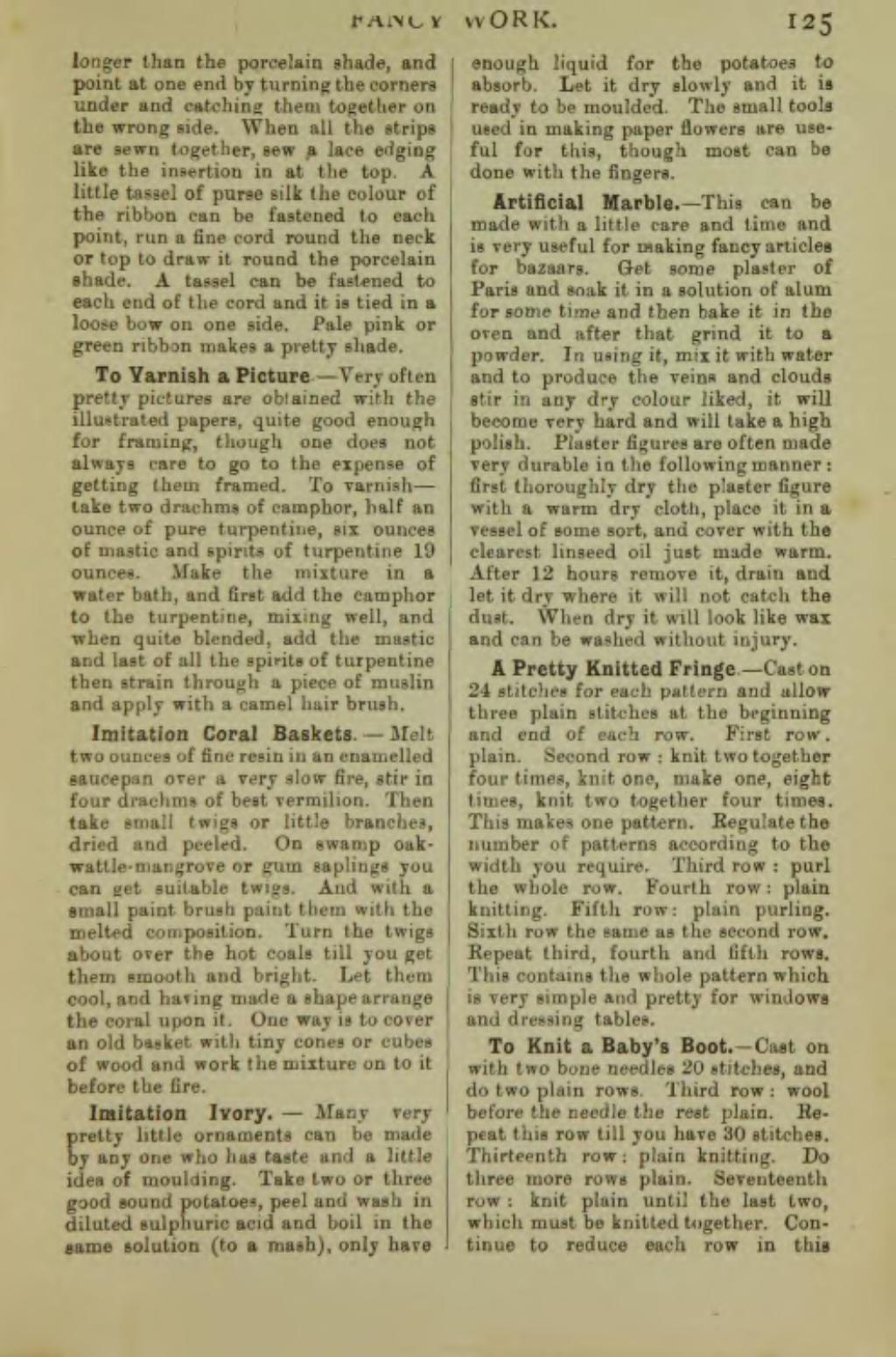|
longer than the porcelain shade, and point at one end by turning the corners under and catching them together on the wrong side. When all the strips are sewn together, sew a lace edging like the insertion in at the top. A little tassel of purse silk the colour of the ribbon can be fastened to each point, run a fine cord round the neck or top to draw it round the porcelain shade. A tassel can be fastened to each end of the cord and it is tied in a loose bow on one side. Pale pink or green ribbon makes a pretty shade.
To Varnish a Picture.—Very often pretty pictures are obtained with the illustrated papers, quite good enough for framing, though one does not always care to go to the expense of getting them framed. To varnish—lake two drachms of camphor, half an ounce of pure turpentine, six ounces of mastic and spirits of turpentine 19 ounces. Make the mixture in a water bath, and first add the camphor to the turpentine, mixing well, and when quite blended, add the mastic and last of all the spirits of turpentine then strain through a piece of muslin and apply with a camel hair brush.
Imitation Coral Baskets.—Melt two ounces of fine resin in an enamelled saucepan over a very slow fire, stir in four drachms of best vermilion. Then take small twigs or little branches, dried and peeled. On swamp oak-wattle-mangrove or gum saplings you can get suitable twigs. And with a small paint brush paint them with the melted composition. Turn the twigs about over the hot coals till you get them smooth and bright. Let them cool, and having made a shape arrange the coral upon it. One way is to cover an old basket with tiny cones or cubes of wood and work the mixture on to it before the fire.
Imitation Ivory.—Many very pretty little ornaments can be made by any one who has taste and a little idea of moulding. Take two or three good sound potatoes, peel and wash in diluted sulphuric acid and boil in the same solution (to a mash), only have
|
enough liquid for the potatoes to absorb. Let it dry slowly and it is ready to be moulded. The small tools used in making paper flowers are useful for this, though most can be done with the fingers.
Artificial Marble.—This can be made with a little care and time and is very useful for making fancy articles for bazaars. Get some plaster of Paris and soak it in a solution of alum for some time and then bake it in the oven and after that grind it to a powder. In using it, mix it with water and to produce the veins and clouds stir in any dry colour liked, it will become very hard and will take a high polish. Plaster figures are often made very durable in the following manner: first thoroughly dry the plaster figure with a warm dry cloth, place it in a vessel of some sort, and cover with the clearest linseed oil just made warm. After 12 hours remove it, drain and let it dry where it will not catch the dust. When dry it will look like wax and can be washed without injury.
A Pretty Knitted Fringe.—Cast on 24 stitches for each pattern and allow three plain stitches at the beginning and end of each row. First row. plain. Second row: knit two together four times, knit one, make one, eight times, knit two together four times. This makes one pattern. Regulate the number of patterns according to the width you require. Third row: purl the whole row. Fourth row: plain knitting. Fifth row: plain purling. Sixth row the same as the second row. Repeat third, fourth and fifth rows. This contains the whole pattern which is very simple and pretty for windows and dressing tables.
To Knit a Baby's Boot.—Cast on with two bone needles 20 stitches, and do two plain rows. Third row: wool before the needle the rest plain. Repeat this row till you have 30 stitches. Thirteenth row: plain knitting. Do three more rows plain. Seventeenth row: knit plain until the last two, which must be knitted together. Continue to reduce each row in this
|
